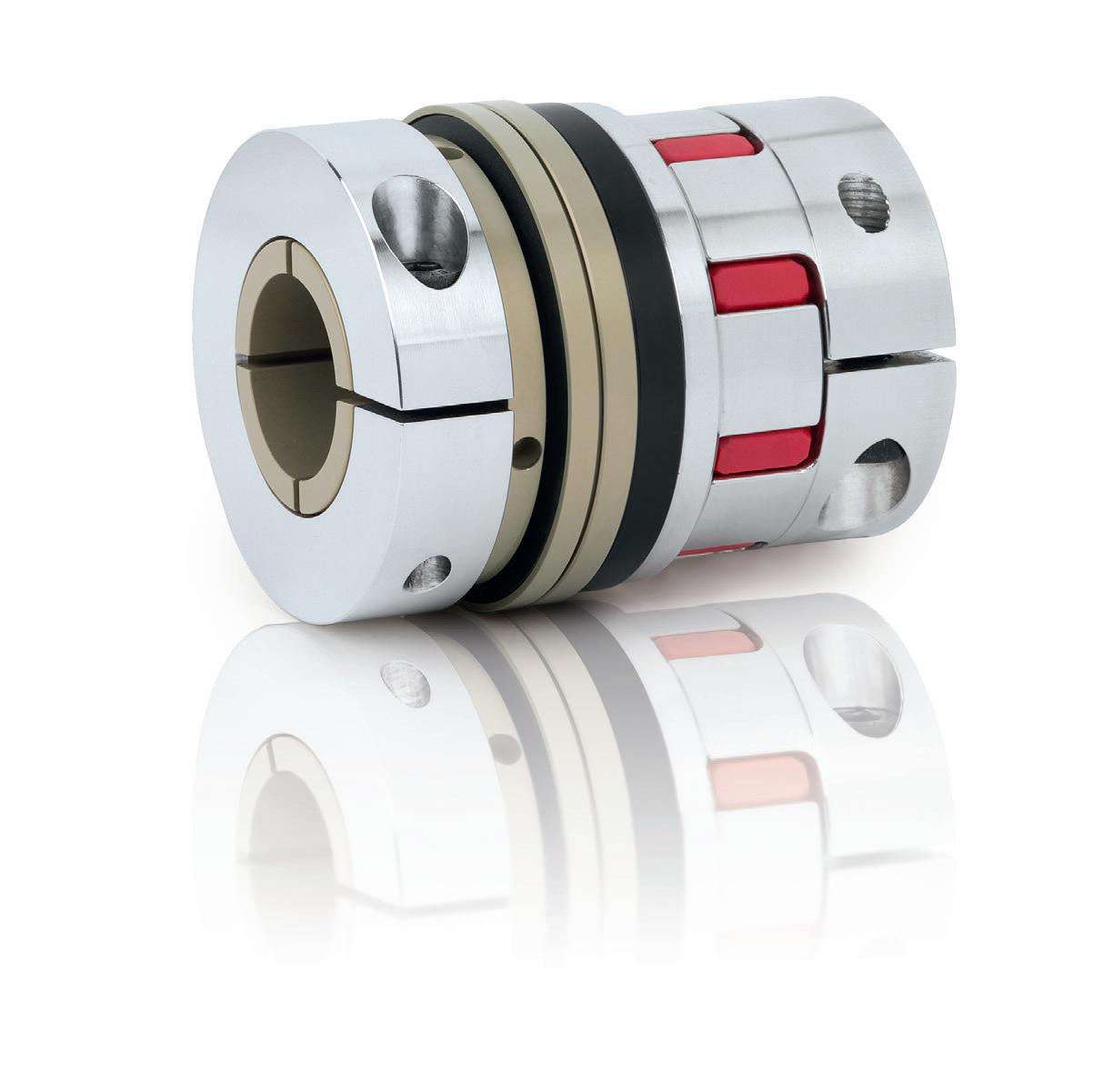
3 minute read
Jaw couplings
Jaw couplings are one coupling type that (depending on the subtype) is suitable for power transmission or servo designs. They come in an array of sizes to accommodate shaft diameters of 3 to 150 mm and beyond.
• Standard industrial jaw couplings have spiders with straight spider arms. Such geometry introduces an oftennegligible amount of play to make assembly easier. These jaw couplings excel in many applications — though not on axes involving highly precise positioning of loads. Some manufacturers refer to these standard couplings as L-jaw couplings.
Such couplings are common in process applications employing electric as well as hydraulic motors and turbines and even gasoline and diesel engines.
• In contrast, zero-backlash jaw couplings include spider arms with a profile ... necessitating a press fit so there’s no clearance between the spider arms and jaws. Some manufacturers refer to these curved-arm couplings as C-jaw couplings.
One representative use of these jaw couplings is on belt-drive linear actuators (tangential belt slides) for the positioning of loads. Such step and servomotor-driven actuators can join the belt pulley and motor … but where the use of servo controllers excite resonances (and other design changes are prohibited) a jaw couplings excel. Their ability to damp axes and move axis operating frequencies away from the assembly resonant frequency is indispensable.

Precision ball-detent torque limiters provide mechanical overload protection that’s indispensable on rotating axes at risk of damage from inertial shock loads resulting from binding and collisions … especially on more modern machinery with faster motor shaft speeds. By providing an overload safety breakaway, the limiters react to actual mechanical torque overload far faster than systems that merely monitor servo amperage draw. Shown here is an SLE torque limiter from R+W America with an elastomeric insert for misalignment compensation.
In fact, some of the largest zero-backlash jaw couplings maintain zero backlash with a heavy press fit ... sometimes requiring assembly with precision press equipment. Despite more challenging assembly, large zero-backlash jaw couplings benefit assemblies by preventing any lost motion in the coupling. Many smaller zero-backlash jaw couplings go together by hand pretty easily.
Have quick reversals? No worries. There are multiple spider materials to match jaw couplings to application needs.
Consider how standard jaw couplings deftly handle shock loads. If the application at hand requires the coupled axis to quickly start and stop, a rigid coupling (or one without cushioning or damping characteristics — such as a zero-backlash jaw coupling) will transmit that shock and can actually accelerate the destruction of the assembly’s bearings on the ballscrew input or motor. In contrast, compliant jaw couplings handle shock loads quite well — even on axes with frequent stops and starts for high throughput.
Here, requiring that the axis decelerate more gently or run softened move profiles just to accommodate a bellows coupling or a rigid coupling is unacceptable. Jaw couplings here impart excellent protection for the life of the design’s motor or actuator — and lets the axis run aggressive move profiles without sustaining damage.
Spider materials and spider hardnesses abound. For example, there’s 98 Shore A, 92 Shore A, and 85 Shore A — sometimes more casually expressed as just 85 durometer. Depending on the amount of cushioning or damping the axis needs, design engineers can fine tune the coupling behavior to suit by strategically choosing from these different spider materials.
Jaw couplings are an inherently failsafe design: If the jaw coupling’s spider is catastrophically damaged, its arms tear off ... and the coupling will go metal-to-metal and still drive. This is useful on applications where it’s important to have a fail-safe design or positive drive. Even zero-backlash jaw couplings work in this manner.
Case in point: The vertical (Z axis) of a semiconductor handling machine might be responsible for lifting and lowering an expensive boat of wafers for wafer processing. Here, suddenly dropping the valuable load could be an expensive error. So to prevent dropping that load in case of failure (and having the screw back drive) a jaw coupling here will act as the positive drive.
One drawback of jaw couplings is that they have fairly low misalignment capabilities ... so require require precision alignment at installation. They do impart a bit of forgiveness, but nothing like beam or other couplings. So if an axis’ halves are misaligned beyond what the jaw coupling is capable of accommodating, that coupling’s will hubs will go in shear, and the spider will degrade ... which in turn results in excessive loading on the axis’ bearings.










